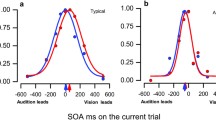Summary
We examined 5-month-old infants' sensitivity to audiovisually coherent and incoherent events. A person speaking and an automobile with engine running were filmed approaching and receding with corresponding (coherent) soundtracks. Infants were tested with a habituation paradigm in which they observed coherent or incoherent films, involving, respectively, acoustical radial motion in the direction seen or opposite to the direction seen. Infants habituated to both person and car films, but coherent events uniformly yielded more rapid habituation than did incoherent ones. In addition, infants treated silent events more like audiovisual coherence than like incoherence. Infants habituated more to cars than to people, suggesting that a speaking person may especially maintain infant attention.
Similar content being viewed by others
References
Aronson, E., & Rosenbloom, S. (1971). Space perception in early infancy: Perception within a common auditory-visual space. Science, 172, 1161–1163.
Bahrick, L. E. (1983). Infants' perception of substance and temporal synchrony in multimodal events. Infant Behavior and Development, 6, 429–451.
Bahrick, L. E., Walker, A., & Neisser, U. (1980). Selective looking by infants. Cognitive Psychology, 13, 377–390.
Bornstein, M. H. (1985). Habituation of attention as a measure of visual information processing in human infants: Summary, systematization, and synthesis. In G. Gottlieb & N. A. Krasnegor (Eds.), Measurement of audition and vision during the first year of post-natal life: A methodological overview. (pp. 253–300). Norwood, NJ: Ablex.
Carpenter, G. C. (1975). Mother's face and the newborn. In R. Lewin (Ed.), Child alive. London: Temple Smith.
Cohen, S. E. (1973). Infant attention behavior to face-voice incongruity. Paper presented at the Society for Research in Child Development, Phila., PA.
Dodd, B. (1979). Lip reading in infants: Attention to speech represented in- or out-of-synchrony. Cognitive Psychology, 11, 478–484.
Dunkeld, J., & Bower, T. G. R. (1980). Infant response to impending optical collision. Perception, 9, 549–554.
Humphrey, K., & Tees, R. C. (1980). Auditory-visual coordination in infancy: Some limitations of the preference method. Bulletin of the Psychonomic Society, 16, 213–216.
Jenkins, J. (1985). Acoustic information for objects, places, events. In W. H. Warren, Jr, & R. E. Shaw (Eds.), Persistence and change: Proceedings of the first international conference on event perception (pp. 115–138). Hillsdale, NJ: Lawrence Erlbaum Assoc.
Lyons-Ruth, K. (1977). Bimodal perception in infancy: Responses to auditory-visual incongruity. Child Development, 48, 820–827.
Morrongielo, B. A. (1988). Infants' localization of sounds along the horizontal axis: Estimates of minimum audible angle. Developmental Psychology, 24, 8–13.
Morrongielo, B. A., & Rocca, P. T. (1987). Infants' localization of sound in the horizontal plane: Effects of auditory and visual cues. Child Development, 58, 918–927.
Pettersen, L., Yonas, A., & Fisch, R. O. (1980). The development of blinking in response to impending collision in preterm, fullterm, and postterm infants. Infant Behavior and Development, 3, 155–165.
Schiff, W. (1965). Perception of impending collision: A study of visually directed avoidant behavior. Psychological Monographs: General and Applied, 79, Whole No. 604.
Schiff, W., & Detwiler, M. L. (1979). Information used in judging impending collision. Perception, 8, 647–658.
Spelke, E. S. (1976). Infants' intermodal perception of events. Cognitive Psychology, 8, 533–560.
Spelke, E. S. (1979). Perceiving bimodally specified events in infancy. Developmental Psychology, 15, 626–636.
Spelke, E. S., & Owsley, C. J. (1979). Intermodal exploration and knowledge in infancy. Infant Behavior and Development, 2, 13–28.
Spelke, E. S., Born, W. S., & Chu, F. (1983). Perception of moving, sounding objects by four-month-olds, Perception, 12, 719–732.
Walker-Andrews, A. S., & Lennon, E. M. (1985). Auditory-visual perception of changing distance by human infants. Child Development, 56, 544–548.
Warren, W. (1982). Auditory perception: A new synthesis. NY: Pergamon Press.
Yonas, A., Bechtold, A. G., Frankel, D., Gordon, F. R., McRoberts, G., Norcia, A., & Sternfels, S. (1977). Development of sensitivity to information for impending collision. Perception & Psychophysics, 21, 97–104.
Author information
Authors and Affiliations
Rights and permissions
About this article
Cite this article
Schiff, W., Benasich, A.A. & Bornstein, M.H. Infant sensitivity to audiovisually coherent events. Psychol. Res 51, 102–106 (1989). https://doi.org/10.1007/BF00309304
Received:
Issue Date:
DOI: https://doi.org/10.1007/BF00309304




